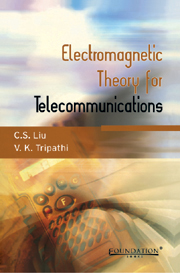Book contents
- Frontmatter
- Contents
- Preface
- 1 Electromagnetic Fields
- 2 Plane Waves
- 3 Guided Waves
- 4 Radiation
- 5 Radio Communication and Radar
- 6 Satellite Communication
- 7 Laser and Optical Fibre Communication
- 8 Geological Seisming and Remote Sensing
- 9 Relativistic Covariance of Electrodynamics
- 10 Radiation from Accelerated Charges
- Appendix A
- Appendix B
- Index
9 - Relativistic Covariance of Electrodynamics
Published online by Cambridge University Press: 26 October 2011
- Frontmatter
- Contents
- Preface
- 1 Electromagnetic Fields
- 2 Plane Waves
- 3 Guided Waves
- 4 Radiation
- 5 Radio Communication and Radar
- 6 Satellite Communication
- 7 Laser and Optical Fibre Communication
- 8 Geological Seisming and Remote Sensing
- 9 Relativistic Covariance of Electrodynamics
- 10 Radiation from Accelerated Charges
- Appendix A
- Appendix B
- Index
Summary
Introduction
Newton's first law of motion, known as the law of inertia, states that a body continues to maintain its state of motion, i.e., its velocity remains constant, unless acted upon by an external force. Conversely, a frame of reference in which the law of inertia holds is called an inertial frame. Any frame, moving with constant velocity with respect to an inertial frame, is also an inertial frame. Thus, one may visualise numerous inertial frames, moving with constant velocities with respect to each other.
Newton believed that there is no preferred inertial frame in nature. The laws of nature are the same with respect to all inertial frames.
A major crisis arose, after Maxwell's equations predicted that the velocity of light in free space is c=1/√μ0∈0, where μ0=4π × 10-7 MKS is the free space permeability and ∈0= 10−9/(36π) MKS is the free space permittivity. Since μ0 and ∈0 are the same in all inertial frames, the velocity of light c, must also appear the same in all inertial frames. How could it be that the velocity of light is c, with respect to a ground observer and it is the same, with respect to an observer moving with an arbitrarily large velocity v also? This violated the law of addition of velocities. Then, it became imperative to change the very foundation of mechanics. Yet there was a suspicion that there might be a very special frame in which the velocity of light was c and it was different in other frames. This suspicion was conclusively demolished by the Michelson-Morley experiment.
- Type
- Chapter
- Information
- Electromagnetic Theory for Telecommunications , pp. 261 - 281Publisher: Foundation BooksPrint publication year: 2007



